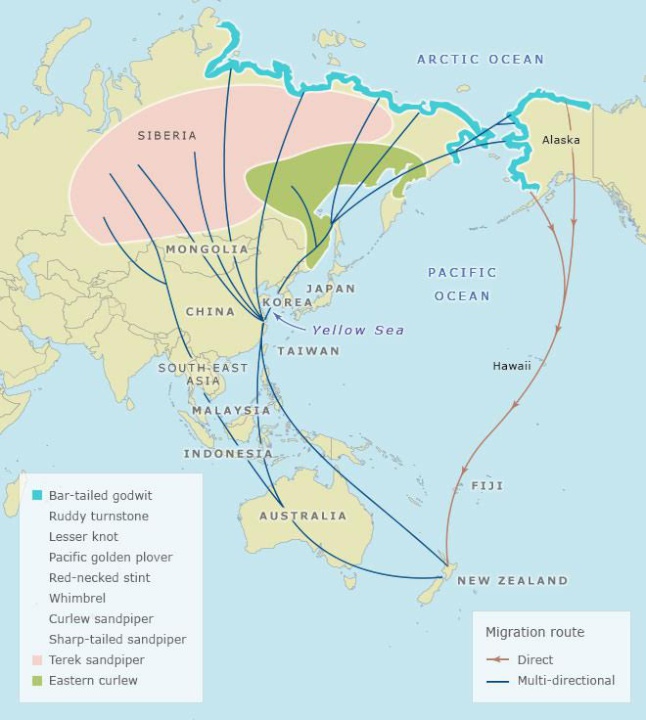International recognition for Avon-Heathcote Ihutai Estuary
PĀNUI PĀPĀHO
MEDIA
STATEMENT
International recognition for
Christchurch’s Avon-Heathcote Ihutai
Estuary
The Christchurch
home of the bar-tailed godwit/kuaka has joined an exclusive
list of wetlands making up the East Asian-Australasian
Flyway (EAAF) network.
The Department of Conservation has been working with the Avon-Heathcote Estuary/Ihutai Trust for the last two years to have the estuary recognised internationally by the East Asian-Australasian Flyway Partnership says Conservation Minister, Eugenie Sage.
“The estuary has a vital role in supporting migratory waders and shorebirds. Its new status emphasises the need to protect this habitat as a safe haven for bar-tailed godwits, lesser knots/huahou, and other shorebirds such as the endemic South Island pied oystercatcher/torea.
“It’s a fantastic achievement for the Avon-Heathcote Estuary/Ihutai Trust for the estuary to now be internationally recognised as part of the East Asian-Australasian Flyway,” Eugenie Sage said.
The EAAF is the series of wetlands used by migratory waders and shore birds, including in their annual migrations. It includes wetland breeding grounds within the Arctic Circle, through East and South-east Asia, to non-breeding areas in South East Asia, Australia and New Zealand. During the birds’ time in Christchurch during our summer they forage in the estuary and put on enough weight to support them on their flight northwards.
Over the last six weeks around 1000 godwits/kuaka have arrived back in the Avon-Heathcote Ihutai estuary after their annual non-stop 11,000-kilometre flight from Alaska.
As a result of habitat loss in the Yellow Sea Region, bar-tailed godwits are declining at an annual rate of 2%. The species is classified as ‘Declining’ in New Zealand.
“With the estuary at Christchurch’s front door and birds easily visible feeding and roosting at a range of sites, it’s easy for residents and visitors to enjoy and understand the estuary’s international significance,” Eugenie Sage said.
Background information:
• A Flyway Site Network (FSN) site is significant to migratory water birds. The site is nominated and accepted by the East Asian Australasian Flyway Partnership. As a designated FSN site there is no legal change in the land status for the Avon-Heathcote Ihutai Estuary.The Avon Heathcote Ihutai Estuary was nominated because it regularly supports greater than 1.8% (up to 2000) of the flyway population of bar-tailed godwits.
• The Ihutai Estuary now joins 136 other wetlands from 20 countries which make up the flyway network. It is the third Flyway Site Network in New Zealand and the second in the South Island.
• Bar-tailed godwits have an extraordinary annual life cycle as they breed in Alaska, spend the non-breeding part of the year in New Zealand and head back to Alaska via the Yellow Sea. They depend on wetlands for food and rest stops.
• The world-wide East Asian-Australasian Flyway (EAAF)was formed in 2006 to emphasise the importance of different wetland areas along the migratory route and to build collaborative conservation activities for migratory water birds.
Links:
https://www.doc.govt.nz/eastern-bar-tailed-godwit
https://www.doc.govt.nz/news/stories/2014/june/the-incredible-godwit-migration/

Map source: https://teara.govt.nz/en/map/7218/the-east-asian-australasian-flyway


 Gordon Campbell: On unemployment, Winston Peters’ low boiling point and music criticism
Gordon Campbell: On unemployment, Winston Peters’ low boiling point and music criticism Labour Party: National Gaslights Women Fighting For Equal Pay
Labour Party: National Gaslights Women Fighting For Equal Pay The Treasury: New Treasury Paper On The Productivity Slowdown
The Treasury: New Treasury Paper On The Productivity Slowdown NZ Government: Government Recommits To Equal Pay
NZ Government: Government Recommits To Equal Pay Emily Ireland - Local Democracy Reporter: Deputy Mayor ‘disgusted’ By Response To Georgina Beyer Sculpture
Emily Ireland - Local Democracy Reporter: Deputy Mayor ‘disgusted’ By Response To Georgina Beyer Sculpture Te Pāti Māori: Māori Unemployment Rate Increases By More Than Four-Times National Rates
Te Pāti Māori: Māori Unemployment Rate Increases By More Than Four-Times National Rates Government: Streamlining Building Consent Changes
Government: Streamlining Building Consent Changes


